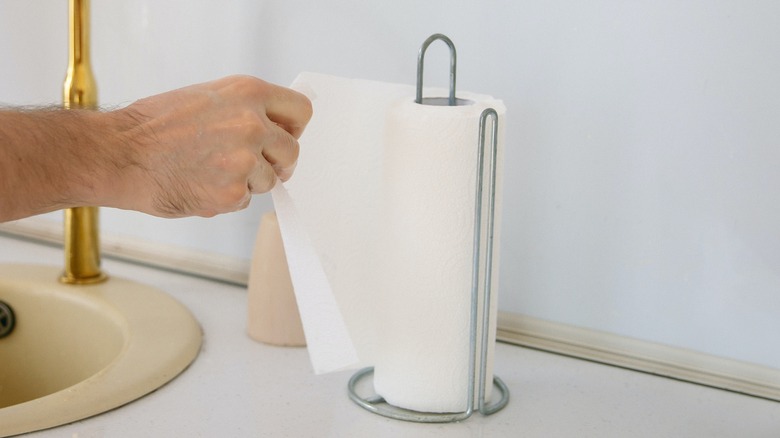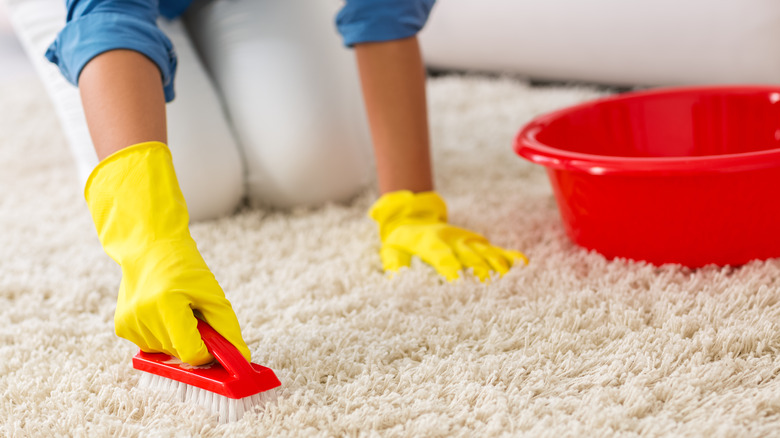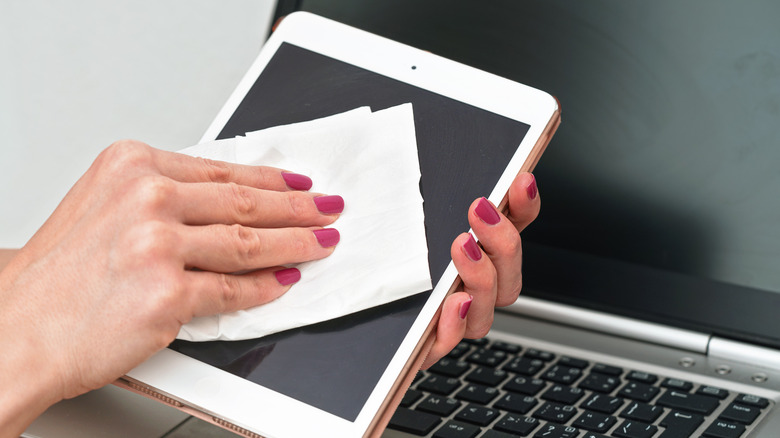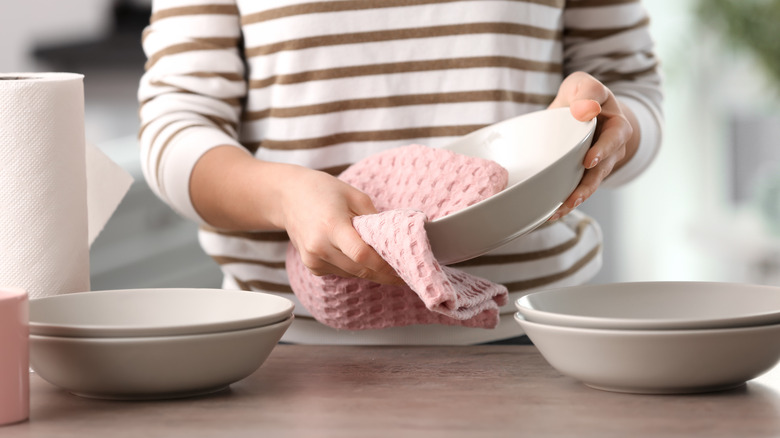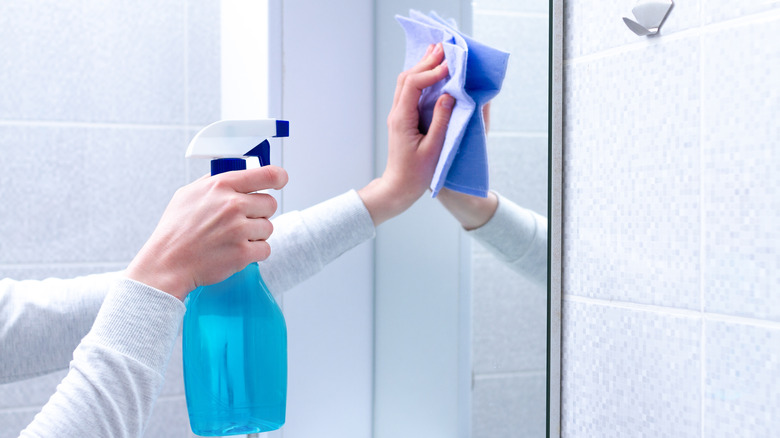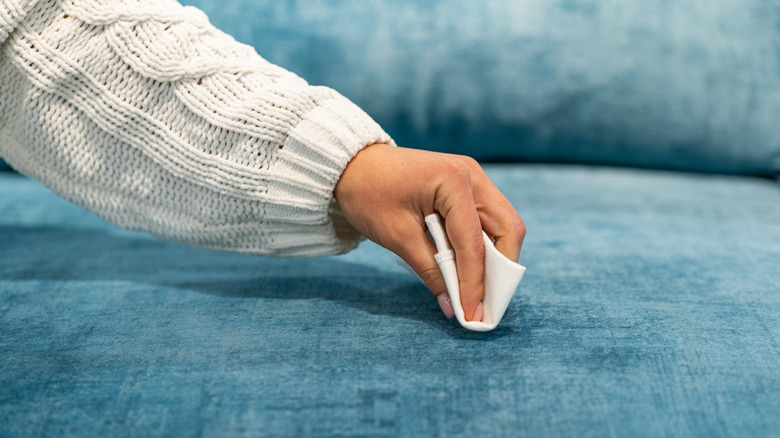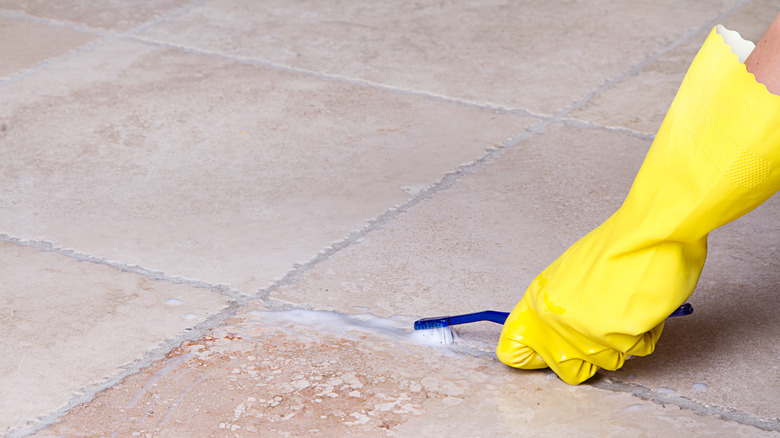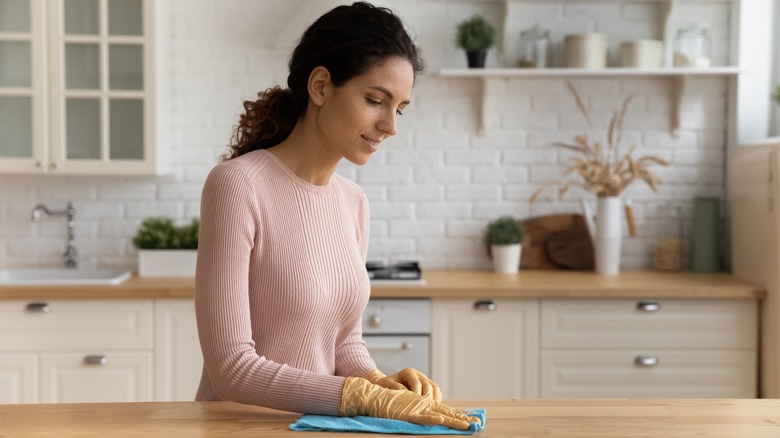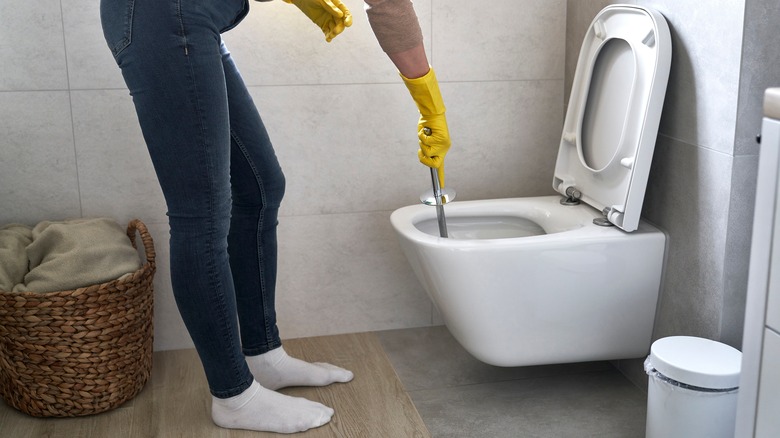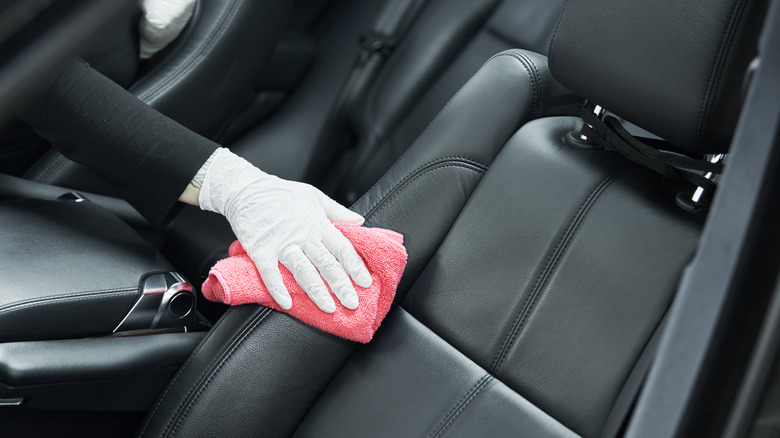Common Things You Shouldn't Clean With A Paper Towel
Paper towels are easily one of the most sought-out household items in the United States. Americans spend as much money on paper towels as the rest of the world combined, proving how much we rely on this disposable resource (via The Atlantic). Although many people rely on these wood-fiber papers for nearly every household and daily task, their original purpose was not so all-encompassing. Paper towels were originally invented as a hygienic alternative to cloth, though their disposable nature makes them seem ideal for most chores around the home. Generally, they make cleaning jobs easier and minimize the size of laundry loads, making them ideal tools for the average person.https://www.homestratosphere.com/why-were-paper-towels-invented/
However, paper towels aren't always the best choice for every job. They are generally weaker than other cleaning instruments, causing them to leave residue or small pieces behind. Paper towels also contain chemicals that may make you think twice about using them for certain chores. Learn more about what's in your paper towels and what home tasks you should never use them for in the list below.
Low to high pile carpeting and rugs
Many homes feature both low and high-pile rugs or carpeting in the living room, bedrooms, office spaces, and hallways. Low pile refers to fabrics with short, tightly looped fibers, while high pile textiles are often shaggy and loosely made. Either way, using a paper towel to clean up messes and spills is not recommended on these surfaces. The paper-like texture of these household tools tears easily on low-pile fabrics, being ripped apart by the short, firm fibers that comprise them. High-pile textiles cause a similar issue, as the long strands easily catch and break up paper towels. This is especially an issue when using a stain remover or other cleaning solution, which moistens the towel in use and makes it even weaker when rubbed against uneven terrain.
Instead of using a paper towel, you should use clean white rags made of microfiber, sponges, or soft-bristled brushes to clean carpets. Don't rub, but carefully blot the stain to remove the mess. If all you have on hand are paper towels, you can use them as a last resort. Just remember that blotting minimizes tearing and reduces the number of remnant pieces left behind, making this a technique to keep in mind. However, you should not use your paper towels if they have a printed design on them, for the dye can rub off on your carpet or rug.
Electronic screens
Over time, fingerprints and dust can accrue on various screens around your home, including smart kitchen appliances, TVs, Google Nests, Apple HomePods, and other electronic devices. It may be tempting just to give them a quick swipe over using a traditional paper towel, but electronic manufacturers warn against using this method. Paper towels can potentially scratch and abrade electronic screens, leaving permanent scratches and indentations on their interface. They also leave lint behind, which isn't as damaging but still a nuisance when you're trying to clean up and not leave more debris.
If any screens in your home need a wipe down, use microfiber cloths, diluted 70-percent isopropyl rubbing alcohol, electronic wipes, or a vacuum with a narrow nozzle attachment. Make sure the fabric you're cleaning with is only damp and not soaked with fluid to avoid causing moisture damage to whatever product you're working on. As always, you should check the manufacturer's manual for the product you're about to wipe down— it may have specific cleaning instructions and advice to use a certain specialized formula instead of rubbing alcohol.
Silverware and dishes
Whether you handwash your dishes or run them through a dishwasher, they may require a quick dry before being put away. Even if paper towels are in close proximity, you shouldn't turn to this resource to dry your glass, ceramic, plastic, or earthenware kitchen items. Paper towels are made with chlorine and formaldehyde, and both chemical byproducts are left behind when you rub them on dishes and silverware. Many paper towel brands also contain Bisphenol A (BPA), which is a chemical thought to affect the brain, circulatory system, and cardiovascular health. The U.S. Food and Drug Administration (FDA) considers BPA to be safe at low levels. However, higher concentrations can have ill effects.
With this in mind, you probably don't want the dishes you eat from to be exposed to the carcinogens detected in many paper towel products. There is no reason to subject yourself to these health risks when you can air dry your items using a dish mat or rack. If you need to dry them more immediately, you can always use a dish towel, although this can spread bacteria if you aren't careful to use a clean cloth.
Mirrors and windows
Using a paper towel on glass housewares, such as windows, furniture, and mirrors, may not have ill health effects, but it is still inadvisable. Using this type of cleaning product makes your efforts futile, as it leaves streaks of lint behind. Ditch the paper towels and use a soft cleaning pad better suited for these tasks— you can use microfiber cloths, which are the usual recommended alternative. Coffee filters, fresh t-shirts, kitchen and bathroom towels, and other soft fabrics also get the job done without leaving residue behind. If you really want to optimize your glass cleaning technique, spot-clean the problem areas first before wiping down the entire item. This keeps you from spreading dust, dirt, and streaks, and helps clump the unsightly residue together, making the job less tedious.
Upholstery
The upholstery in your home is the soft materials that make up many furniture pieces, usually couches, armchairs, dining chairs, ottomans, and other seating options. These materials are synthetic or all-natural textiles; cotton, leather, linen, nylon, polyester, silk, velvet, or synthetic blends. No matter which fabric makes up most of your upholstery, you should not be using paper towels to clean these items.
The fibers in textiles easily tear and rip paper towels, leaving paper trails in the wake of your wiping. Paper towels can even make a mess worse when cleaning up a spill; you'll just rub a stain deeper into your furniture, making it more difficult or impossible to remove. Darker fabrics are especially susceptible to these problems since the white residue from paper towels is more visible on these types of upholstery. You can avoid the complications associated with paper towels by washing your fabrics based on manufacturer instructions and cleaning guidelines. You should know that furniture manufacturers created a universal system for washing upholstery fabrics based on an alphabetized code. This code is indicated by a letter on your furniture tag, which explains how to clean your product using dry or water-based procedures.
Grout lines
Many homeowners make the mistake of trying to clean grout with paper towels, and they learn the hard way that this is ineffective and creates a bigger mess. Grout is a hardened mixture of sand, cement, and water, which is often used to fill the gaps between wall and floor tiles. It usually has a sandpaper-like texture that is rough to the touch and will easily shred paper towels. Wet or dry paper fibers will snag on the grout lines, creating a more sizable mess than what you started with.
You'll need to use a more specialized process for grout-related cleaning endeavors. A broom, sponge mop, or towel will better suit the task at hand, and some people even use toothbrushes to scrub the thin lines between their tiling. The best recommendation is to use specialized grout sponges for the task since everyday cleaning tools are at risk of tearing the way paper towels do.
Wood furniture
Wood is one of the most popular natural resources for making household furniture. Bed frames, cabinets, chairs, decorative objects, tables, and other items are built from different types, including natural wood products, engineered particleboard, rattan, and wicker materials. When dusting or cleaning this type of furniture, you don't want to use paper towels. They have the potential to damage the wood by scratching its finish, especially if you're dry-dusting. If you're cleaning up a spill, they're often not absorbent enough to soak the spill up completely, at least, not without having to use several paper towels.
Wood furniture should be cleaned using a soft cloth and with a wood-specific formula or a diluted cleaning solution. Many finishes are easily damaged by dust and small debris, which is why paper towels are so impractical for the task. You should also use another cloth to completely dry the wood after you finish the scrubbing step of the cleaning process.
Toilet bowls
When considering the practicality of using paper towels to clean toilets, health concerns again come into play. Unless you're equipped with substantial PPE (personal protective equipment), such as elbow-length rubber gloves, you probably don't want to get too close to the fixture where human waste is disposed of. This makes a toilet brush the best tool for the job since you can scrub down the inner pot with an extended pole.
Paper towels put your hands in dangerously close proximity to the powerful cleaning chemicals used to scour a toilet, and the towels themselves can be damaging to your plumbing appliance. If pieces of the paper fibers break off and get flushed into plumbing lines, they take between two to four weeks to biodegrade. This can lead to clogs in your septic and plumbing system, cause a backed-up toilet, and result in house damage, making the common household commodity highly unadvisable for this chore.
Car interiors and exteriors
There is a final belonging that you should never use paper towels on; a personal vehicle, specifically all car makes and models. You already know the issues with using paper towels for most situations; they break apart, leave lint trails, contain trace chemicals, and can cause plumbing blockages. When using them to clean your car, you should keep many of these points in mind. However, you should also consider an additional one — you'll need to use an abundant number of paper towels to cover the many spaces inside and outside your vehicle. The exterior paint job, windows and windshield, dashboard, plastic casings, and upholstery would take multiple rolls of paper towels to wash and dry. Although this popular household item may be considered "disposable," you should consider that it'll fill up your trash bag quickly and be quite costly for a single cleaning job.
You'll be paying to use an entire case of paper towels when a chamois or spare rag does the job much more effectively. Using a soft cloth is also less likely to scratch your car's paint job. You may not notice the marks right away, but microabrasion is sure to occur with repetitive paper towel use.
